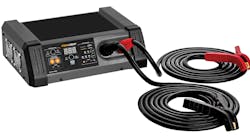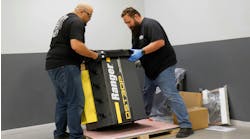Tool Review: Clore Automotive SOLAR 12V 100A Flashing Power Supply and 100/40/10A Battery Charger
Demand on the electrical systems in today’s vehicle is significantly higher than in the past. Modern vehicles include computers for virtually everything the vehicle does, from fuel ratios to the infotainment system. Many of these modules require memory to be stored, so even when the vehicle is not running, there is some amount of drain on the battery.
Additionally, many vehicle system updates and reprogramming require the vehicle’s ignition to remain in the on position without any dips or spikes in power, often for hours at a time.
Eric Moore, fleet manager at Griffin Pavement Striping in Columbus, Ohio, had been dealing with all of these issues using different devices and workarounds. Then he discovered the Clore Automotive SOLAR 12V 100A Flashing Power Supply and 100/40/10A Battery Charger, No. PL6800, and managing electrical systems became a lot more convenient.
Griffin Pavement Striping has to perform regular updates on striping equipment, Moore says, and those updates can sometimes take up to eight hours.
“We've noticed several times in the past when using just a battery charger that the voltage will fluctuate or it'll spike,” Moore says. “Or, someone will forget and not leave [the charger] on hold; they'll set the timer so it'll only go for an hour and a half and then cut off and no one knows, then all of a sudden the battery voltage drops.”
When the voltage spikes or drops, the update process will often have to be restarted from the beginning. Using the PL6800 saves the technicians at Griffin time by avoiding these fluctuations in voltage.
“The Clore PL6800, that thing is rock solid,” Moore says. “You can actually set the voltage where you want it to be, and it stays there the whole time. It’s really nice.”
In addition to using the PL6800 as a maintainer, Moore and the technicians at Griffin also use it in its other capacity: as a battery charger.
“We have lawn and garden batteries that are on some of our smaller equipment,” Moore says. “We charged the battery on a couple of our [Toyota] Tundras and [the batteries] on our Freightliner.”
Moore explains that much of their equipment sits idle during the winter months, and the cold and lack of use eventually drains the batteries of most of their charge. The PL6800 has a solution for that as well.
“There is a recovery feature on this charger, where as long as it reads a certain [very low] percentage of charge in the battery, it will try to recover the battery,” Moore says. “It will try to step the charging in such a way that it recovers it so you won't get a chargeback.”
The recovery feature is part of the PL6800’s “smart” charging capability which uses microprocessor-controlled logic to automate the battery charging process. This also allows it to charge batteries more quickly than a standard charger.
“I like the fact that it starts out at a high rate of charge,” Moore says. “[When] you select Charge, and hook your battery up, it instantly goes to 15.4 [volts] and then it slowly steps it down. It also has the option for you to select the percentage of charge so you can see where you're at, where it's charging the battery.”
When the PL6800 first arrived at Griffin, it was packaged in a sturdy box and securely wrapped in bubble wrap, Moore says. Included in the box was the device itself, the charging cables (which Moore says are “basically like a welding cable”), the power cord, and the instruction manual. Moore read the instructions, but says the device is so straightforward to use that he wouldn’t necessarily have needed to.
The only minor hiccup getting started with the PL6800 was wiring the correct style outlet for the device, Moore says. Since the PL6800 requires 20A service, the power cord uses a plug that resembles a standard three-prong 110V plug, but one of the flat prongs is horizontal instead of both being vertical. Once this issue was remedied, the technicians began using the PL6800 with no further trouble.
Since he’s been using it, Moore has been thoroughly impressed with the Clore device’s quality and its performance as both a maintainer and a battery charger.
“It's pretty impressive, and the quality is there,” he says. “It's just such a home run.”




